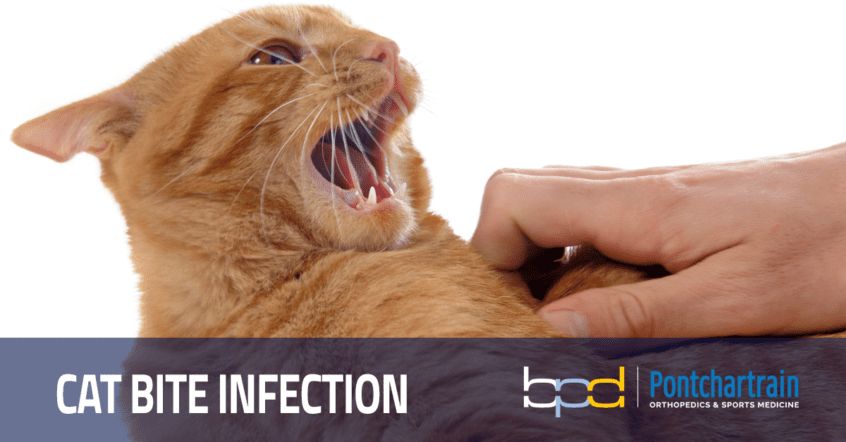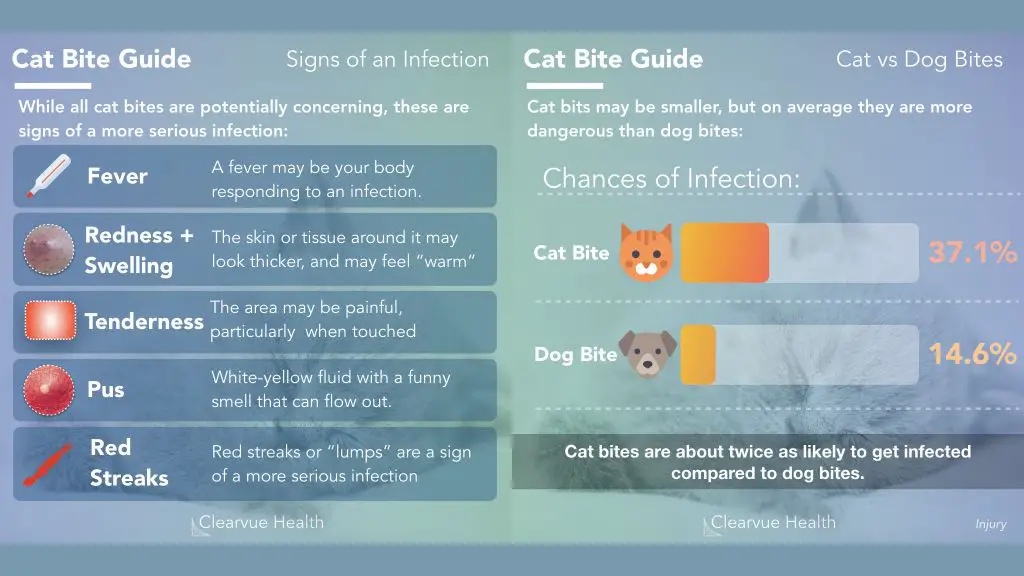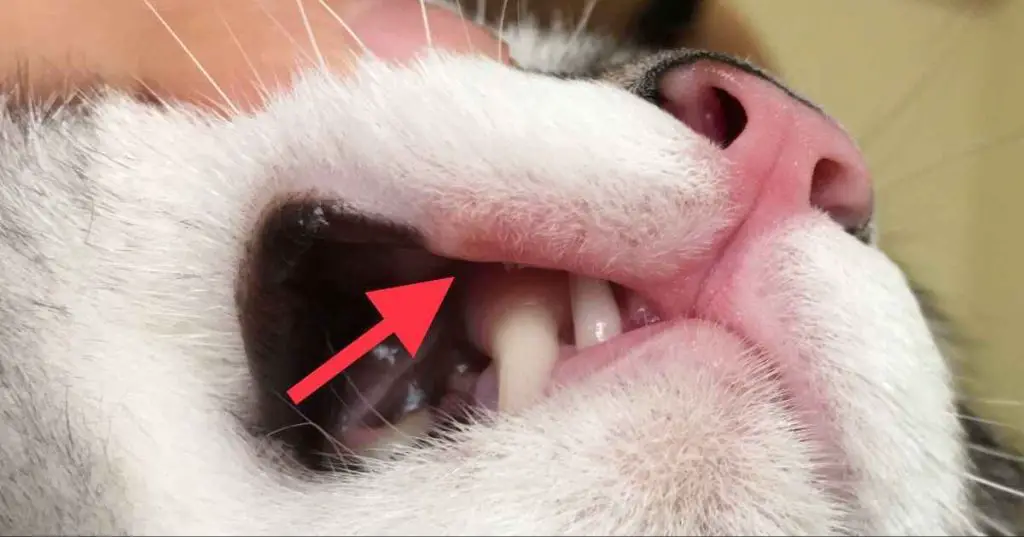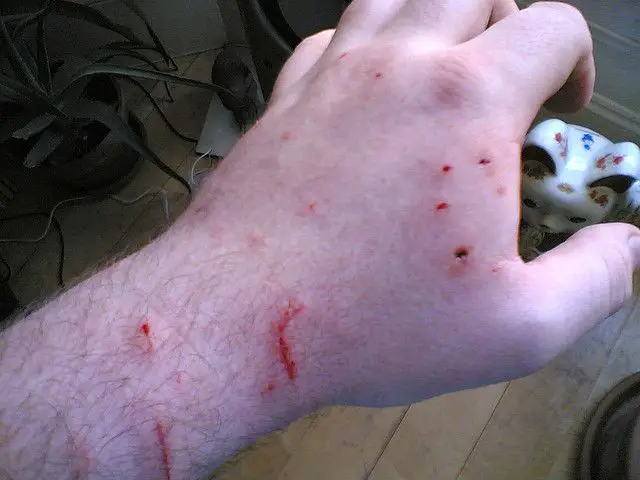Cat bites are wounds caused by the teeth of a cat piercing the skin. Cat bites differ from scratches, where the skin is raked by the cat’s claws but no puncture wound occurs. Cat bites can range from small punctures to deep wounds if the cat’s sharp teeth pierce deeply into the skin and underlying tissues. Cat bites can occur from provoked or unprovoked incidents. Provoked bites often happen when cats feel threatened, such as from handling, grooming, or vet visits. Unprovoked bites occur when a cat seems relaxed but suddenly bites “out of the blue” for no apparent reason.

While many cat bites are minor, all cat bites carry a high risk of infection. Cat teeth can inoculate bacteria deep into tissues. CAT bites have higher infection rates than dog bites, with studies showing up to 80% of cat bites becoming infected if left untreated. Even a small puncture can cause a serious infection. Infection rates are high because cats have sharp, needle-like teeth that inject bacteria deep below the skin. Cats also have a unique oral flora with very pathogenic bacteria such as Pasteurella multocida that can cause rapidly spreading infection. Prompt medical care is essential for all cat bites.
How Common Cat Bites Are
Cat bites are not uncommon. According to the CDC, there are approximately 400,000 cat bites every year that require medical attention. Studies show that cat bites account for 5-15% of all animal bites reported. Males between the ages of 5-9 are the most frequent victims of cat bites. Most cat bites occur in the summer months and in the morning hours between 4am-8am. The arms are the most common body part to be bitten by a cat.
While less frequent than dog bites overall, cat bites have a higher rate of infection – between 15-20%. This is due to the shape of cats’ teeth and the bacteria present in their mouths. Cat bites penetrate deeply and inoculate bacteria deep into tissue where it is hard to clean.
Signs of Infection

Cat bites that get infected will likely show signs of infection within 12 to 24 hours after the bite occurred. Some common signs of infection from a cat bite wound include:
- Redness around the bite – As bacteria multiply in the wound, inflammation and redness spreads from the bite.
- Swelling around the bite – Fluid accumulation and inflammation causes the tissue around the bite to swell.
- Pus draining from the bite – Pus is made up of fluid, dead cells, and bacteria. Its presence indicates infection.
- Fever – A fever can develop as the body reacts to the infection. Fevers from infected cat bites are often over 101°F.
According to the CDC, redness and swelling at the bite site and fever are common symptoms of the bacterial infection Capnocytophaga from a cat bite[1]. Pus draining from the wound is also a clear sign the bite is infected.
If any of these signs of infection appear, it is important to promptly seek medical care to get the infected cat bite properly treated.
Causes of Infection
Cat bites commonly become infected because of the bacteria present in cats’ mouths. Cats harbor a wide variety of bacteria, including Pasteurella multocida, Staphylococcus, Streptococcus, Fusobacterium, and Bacteroides (1). Many of these bacteria are opportunistic pathogens that can cause infections if introduced into tissues through a bite or scratch.

According to VCA Animal Hospitals, “Pasteurella multocida is the most common bacteria found in infected cat wounds. Studies have shown that Pasteurella multocida can be cultured from over 50% of infected cat bite abscesses. This bacteria is found in over 90% of cat mouths” (https://vcahospitals.com/know-your-pet/wounds-cat-bite-injuries-to-humans).
Deep puncture wounds caused by cat bites provide ideal conditions for bacterial growth and infection. The bacteria are implanted deep into the tissues, where the immune system has difficulty reaching them. Abscesses or infected cysts often develop when bacteria multiply inside these closed puncture wounds.
Risk Factors
Certain factors increase the risk of a cat bite becoming infected. According to a study published in Pubmed, the main risk factors are:
- Deep puncture wounds – Cats have sharp, pointed teeth that can penetrate deeply into skin and tissue. Deeper bites have a higher chance of infection.
- Bites to the hand – Hands have less soft tissue and muscle covering bones and joints. Bites here allow bacteria quick access to penetrate deeper.
- Compromised immune system – People with weakened immune systems, such as the elderly, diabetics, or those on immunosuppressant medications have a harder time fighting off infections.
Knowing these risk factors allows quicker identification of high risk bites that require urgent medical care to prevent complications.
Preventing Infections

Preventing infections from cat bites starts with proper first aid right after the bite occurs. The first step is to immediately clean the wound thoroughly with mild soap and warm water. Gently rinse away any dirt or debris in the bite. According to VCA Hospitals, “You may clean the wound with a mild soap solution or a mild salt solution.”
Applying an antibiotic ointment can help prevent bacterial infection. Cover the wound with a sterile bandage to keep it clean. If the bite has broken the skin, seek medical attention even if it appears minor. Cat bites can introduce bacteria deep into tissues where it is hard to clean.
For moderate or severe bites, a doctor may prescribe oral antibiotics as a preventative measure against infection. Antibiotics commonly used include amoxicillin-clavulanate (Augmentin), ampicillin-sulbactam (Unasyn), and cephalosporins like cefuroxime (Kefurox). Taking antibiotics as prescribed is important to fully prevent infection.
Seeking prompt medical care for cat bites provides access to professional wound cleaning, antibiotic administration, stitches if needed, and tetanus shots. Doctors can also assess the bite for signs of infection and the risk of complications. Early treatment greatly reduces the chances of developing infections from cat bites.
Treating Infections
If a cat bite becomes infected, treatment typically involves antibiotics, draining any abscesses that form, and sometimes hospitalization.
Doctors usually prescribe oral antibiotics like amoxicillin/clavulanic acid as a first-line treatment for infected animal bites [1]. Antibiotics help kill bacteria and stop the infection from spreading further in the body. Depending on the severity, intravenous antibiotics may be given in the hospital.
If pus collects under the skin, this is called an abscess and needs to be drained. A doctor will numb the area, make a small cut, and drain the pus out. Packing material may be placed in the wound to keep it open so it can continue to drain. Draining abscesses helps remove the infection.
Hospitalization is sometimes required for severe cat bite infections. This allows close monitoring and intravenous antibiotics if needed. Surgery may be done to thoroughly clean the wound, remove damaged tissue, or drain abscesses. Hospitalization aims to control the infection before it spreads deeper into the tissues.
Complications
Some of the most serious complications that can arise from a cat bite infection include:
Joint/bone infections: Infections that penetrate deeper into the tissue can spread to joints and bones. According to the CDC, joint infections occur in up to 25% of cat bite wounds. This can lead to septic arthritis, requiring intensive antibiotic treatment or even surgery to clean out the infected joint.
Blood infections: The bacteria from a cat bite can spread via the bloodstream, leading to a serious condition called sepsis or septicemia. Symptoms include fever, chills, low blood pressure, and confusion. Sepsis requires emergency medical treatment with IV antibiotics and fluids.
Nerve damage: Bacteria from deep puncture wounds can infect the nerves and cause permanent nerve damage. One study found that 13% of hand infections from cat bites resulted in sensory loss or motor weakness. Nerve damage can impair function and sensation in the affected area.
Recovery
Recovery time for an infected cat bite depends on the severity of the infection. Minor infections may take 1-2 weeks to fully heal. More serious infections that require hospitalization can take 4 weeks or longer to recover. Healing times also depend on the location of the bite, with hand and foot injuries often taking the longest.
Proper wound care is essential during recovery. This involves keeping the wound clean and covered. Your doctor may recommend soaking the wound in salt water or gentle washing with soap and water to remove debris and drainage. Change dressings frequently to prevent bacteria from growing. Take any antibiotics prescribed until finished.
Scarring is common with infected cat bites, especially if they were deep puncture wounds. The infection causes inflammation and damage that can lead to raised, discolored scars. Bites on the hands, arms or legs are most prone to noticeable scarring. Massaging the healed wound with lotion can help soften and flatten scars over time. More severe scarring may require professional treatment like steroid injections or laser therapy.
Prevention
Cat bites can often be prevented through proper training and care. Some key tips for prevention include:
Training cats not to bite – Start training and socializing cats at a young age not to bite. Use positive reinforcement to reward gentle behavior. If they start to bite, say “no” firmly and walk away to show that biting results in playtime ending. With adult cats, withdraw attention when they bite and reward calm behavior.
Playing safely – Redirect aggressive play towards appropriate scratching posts and toys. Use interactive wand toys to keep hands away from mouths. Avoid rough play like wrestling that can rile up cats. Monitor children playing with cats and teach them how to properly interact.
Providing veterinary care – Keep cats up-to-date on vaccines and vet visits to detect any medical issues contributing to biting like dental disease or arthritis. Consider declawing if other options have failed, but be aware of potential complications. Discuss behavior modification options with your vet as well.
With diligent training, proper playtime, and veterinary care, many cats can be taught not to bite people. It takes patience and consistency, but the payoff is a calmer, gentler cat.

